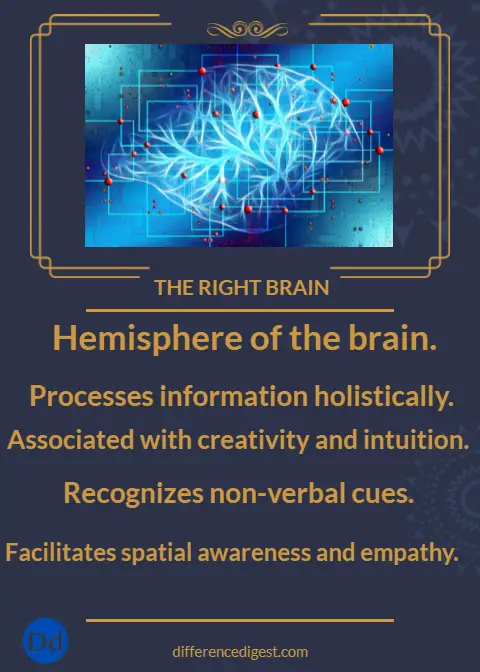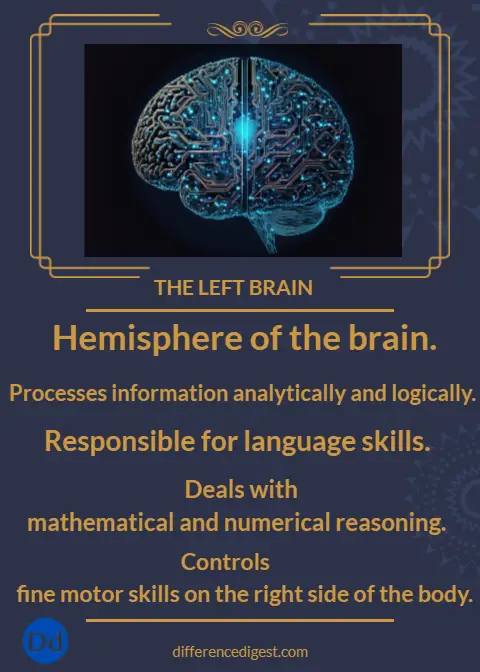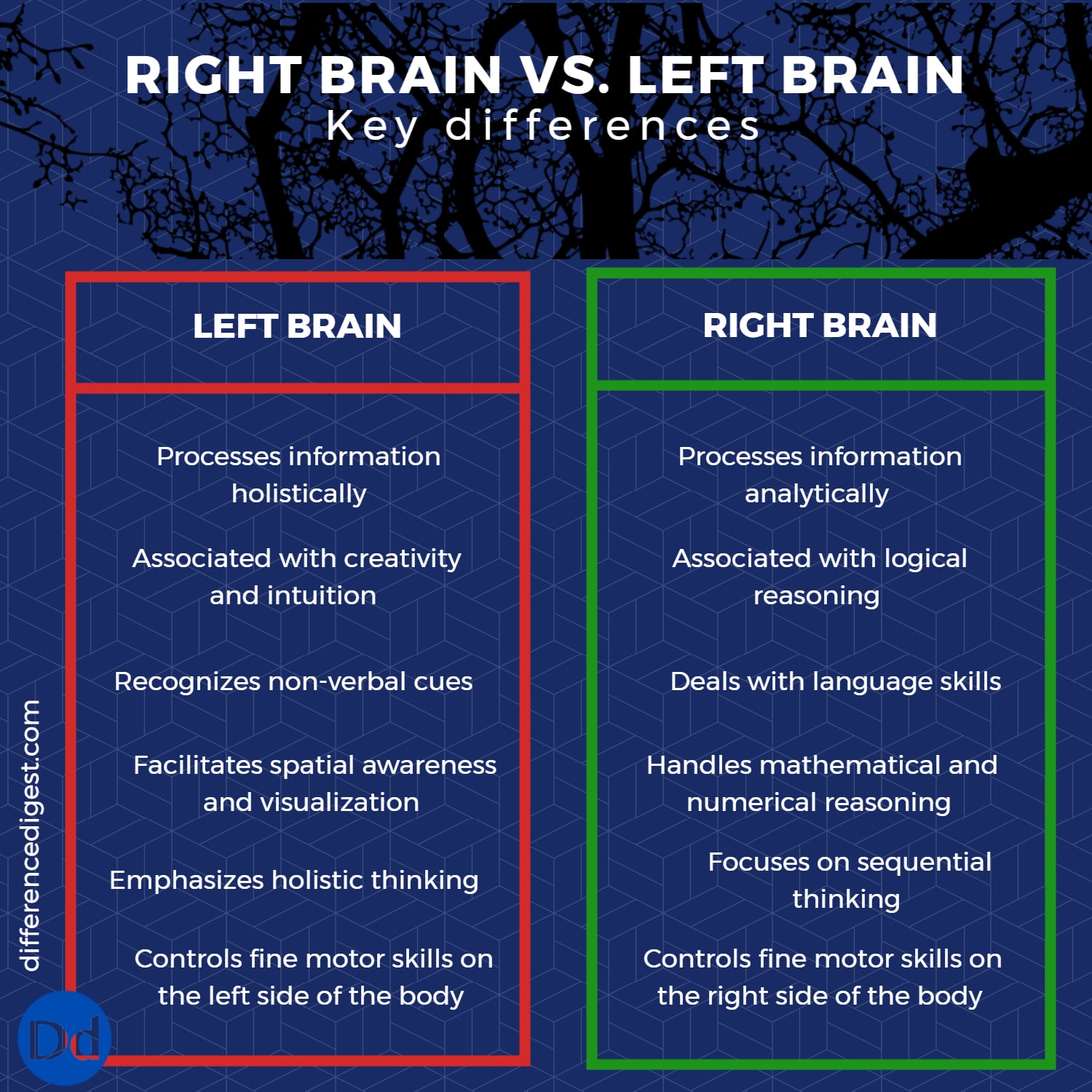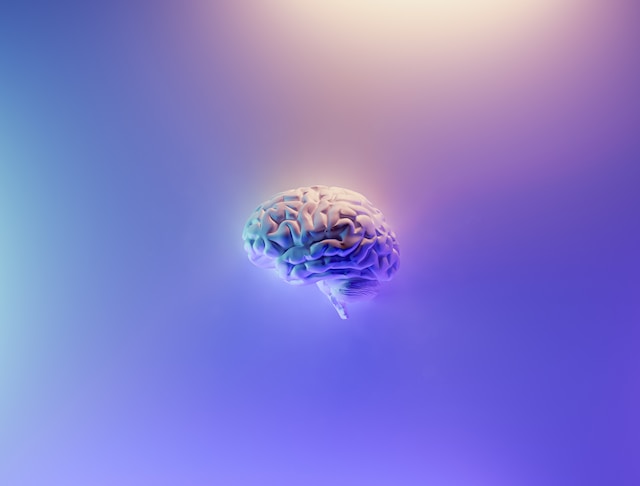The right brain is associated with creativity, intuition, and holistic thinking, while the left brain is linked to logical reasoning, analytical thinking, and language skills.
What is the right brain?

The right brain is often associated with creativity, intuition, and holistic thinking. It’s responsible for processing information in a more visual and spatial way, allowing us to recognize faces, images, and patterns. This side of the brain also helps us understand emotions and pick up on nonverbal cues.
One unique feature of the right brain is its ability to see the big picture. Unlike the left brain which focuses on details and specifics, the right brain takes in all aspects of a situation or problem at once. This can make it easier to find creative solutions or come up with new ideas.
In addition to its role in creativity and emotional intelligence, studies have shown that the right hemisphere may be involved in some language functions such as understanding metaphorical language or interpreting tone of voice.
It’s worth noting that while there are certainly differences between how our two hemispheres function, they’re not completely separate entities. The left-brain/right-brain divide is actually an oversimplification – both sides work together constantly to help us make sense of the world around us.
What is the left brain?

The left brain is responsible for logical and analytical thinking. It processes information in a sequential and organized manner, making it well-suited for tasks that require attention to detail and accuracy. This side of the brain is associated with language comprehension, mathematical skills, and reasoning abilities.
People who are left-brained tend to excel at solving problems using facts, figures, and data. They thrive in structured environments where rules are clearly defined. Left-brained individuals also have excellent memory retention skills when it comes to details such as dates or numbers.
However, this emphasis on logic can sometimes lead to a lack of creativity or flexibility in thinking. Left-brained individuals may struggle with abstract concepts or situations that do not have clear-cut solutions.
The left brain plays an important role in our cognitive functions by helping us make sense of complex information through analysis and deduction. Its strengths complement those of the right brain to help us navigate various aspects of our lives from work to personal relationships.
How do the two sides work together?
The two sides of our brain, left and right, are responsible for different cognitive functions. While the left side is associated with logical thinking, analytical skills, and language processing, the right side is linked to creativity, intuition, and spatial awareness.
Despite these differences in function, both sides work together in a seamless manner that allows us to perform complex tasks such as driving a car or playing an instrument without even realizing it. The corpus callosum connects the two hemispheres of the brain allowing them to communicate with each other.
For instance; when we read a book (a typical left-brained activity), our eyes move across the page while we process information about characters and plot using language centers on both sides of our brains. Meanwhile; visualization centers on the right hemisphere help us imagine scenes from what we’re reading.
Similarly; when solving math problems (a typical right-brained activity), we use logic and analytical skills associated with our left hemisphere but also rely on spatial awareness linked to our right hemisphere.
Whether performing routine daily activities or engaging in more creative pursuits -both halves of your brain are constantly working together- seamlessly integrating their unique strengths into everything you do!
Right brain Vs. Left brain – Key differences

The human brain is a complex network of neurons responsible for an array of thought processes, emotions, and physical actions. The commonly referred right-brain vs. left-brain theory suggests that the two hemispheres control different modes of thinking.
The left hemisphere controls analytical and logical reasoning skills. People who are more left-brained tend to excel in fields such as math and science where precise calculations are necessary.
On the other hand, people who lean towards being right-brained have superior artistic abilities and tend to think creatively. They are better at recognizing patterns, music composition or painting than their left-brained counterparts.
Moreover, while the left brain focuses on language’s meaning and structure to communicate with others efficiently; the right brain is responsible for interpreting nonverbal cues such as body language or tone of voice during communication.
In essence, knowing which part of your brain you rely on more can help you understand your strengths better and potentially improve on your weaknesses by engaging in activities that challenge those parts less-used by oneself.
Advantages of being right brained
Have you ever been told that you’re right-brained? If so, consider yourself lucky! Being right-brained comes with a lot of advantages that can help you excel in many areas.
One of the biggest advantages is creativity. Right-brained people are often highly creative and able to think outside the box. They have a natural ability to see things from different angles and come up with unique solutions to problems.
In addition to creativity, right-brained individuals tend to be more intuitive than their left-brained counterparts. They have a strong sense of empathy and are able to pick up on subtle cues from others that may go unnoticed by someone who’s more analytically minded.
Another advantage of being right-brained is an appreciation for beauty. Right-brainers are often drawn to art, music, and other forms of expression that appeal to the senses. This appreciation for aesthetics can enrich one’s life in countless ways.
Those who are right-brain dominant tend to be excellent at holistic thinking – they can take large amounts of information and distill it down into meaningful patterns or ideas. This makes them ideal candidates for careers in fields like design, marketing, or education where this skillset is valued.
Being right brained offers plenty of benefits that make life more interesting and fulfilling!
Advantages of being left brained
Left-brained individuals are known for their logical and analytical thinking skills. They tend to excel in fields such as math, science, and engineering due to their ability to process information logically and systematically. This can come in handy when it comes to tackling complex problems or tasks that require a step-by-step approach.
Another advantage of being left-brained is the attention to detail they possess. They have an eye for small details which allows them to catch errors that others may miss. This trait can be particularly useful in professions such as accounting, law, or medicine where precision is crucial.
Furthermore, left-brained people often have excellent memory recall abilities. They are able to store large amounts of data efficiently which makes them great at memorization tasks like learning languages or studying historical events.
In addition, left-brained individuals usually thrive on structure and routine which enables them to stay focused on their goals without becoming easily distracted. This trait also means they tend to be highly organized which translates well into both personal and professional life.
Being left-brained has its advantages when it comes to logical reasoning skills, attention-to-detail abilities, memory recall capabilities and an affinity towards structured routines – all of these traits help one succeed with ease!
What are the weaknesses of a right-brained person?
Right-brained individuals are often known for their creative and imaginative minds, but they also have some weaknesses that can hold them back. One of the main challenges faced by right-brained people is their tendency towards impulsiveness. They may make decisions based on intuition rather than logic, which can result in poor outcomes.
Another weakness that right-brained individuals face is difficulty with organization and time management. They tend to be more spontaneous and flexible, which can make it challenging to meet deadlines or stick to a schedule. This can create stress and anxiety when trying to balance multiple tasks or responsibilities.
In addition, right-brained people may struggle with analytical thinking and problem-solving. While they excel at generating new ideas and possibilities, they may struggle with breaking down complex issues into manageable parts or finding practical solutions.
Because right-brained individuals often prioritize creativity over conventionality, they may struggle with conformity or following rules. This can lead to conflict in structured environments such as academic settings or corporate workplaces.
While being right-brained comes with many strengths, it’s important for individuals to recognize their weaknesses so that they can work on developing skills in areas where they need improvement.
What are the weaknesses of a left-brained person?
While left-brained individuals excel in logical reasoning and analytical skills, they may struggle with certain aspects of creativity and imagination. Due to their methodical approach to problem-solving, they can often become rigid in their thinking, which may limit their ability to think outside the box. This lack of flexibility can hinder a left-brained person’s ability to come up with innovative solutions that require creative thinking.
Moreover, left-brained individuals tend to be more detail-oriented but may have difficulty seeing the big picture. They often focus on individual components rather than how those pieces fit together into a larger whole. As a result, they may miss connections or fail to see patterns that could lead to new insights or ideas.
In addition, left-brain thinkers can sometimes struggle with interpersonal communication skills due to their tendency towards factual accuracy and objectivity over emotional intelligence. They may not pick up on nonverbal cues or empathize as easily as right-brained individuals do.
However, it’s important to note that these weaknesses are not inherent for all left-brained people; everyone has different strengths and weaknesses regardless of which side of the brain dominates their cognition.
| Right-Brained Persons | Left-Brained Persons |
|---|---|
| May struggle with structured organization and time management | May struggle with creativity and thinking outside the box |
| Might have difficulty focusing on details and may overlook important information | May rely heavily on logic and may overlook emotional or intuitive aspects |
| Can be prone to impulsivity and lack of planning | May have difficulty in recognizing and interpreting non-verbal cues |
| May find it challenging to follow rigid rules and procedures | May struggle with visual-spatial tasks and lack artistic abilities |
| May face challenges in tasks requiring logical analysis and sequential thinking | May have difficulty in expressing emotions and connecting with others on an emotional level |
Featured Image By – Milad Fakurian on Unsplash









